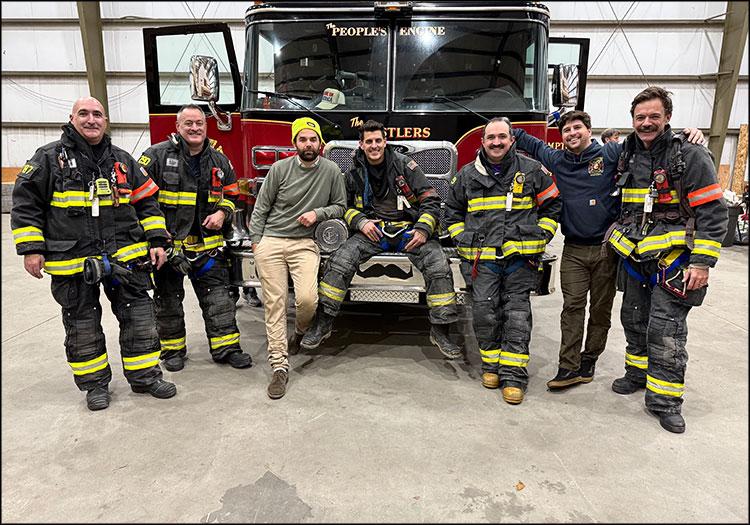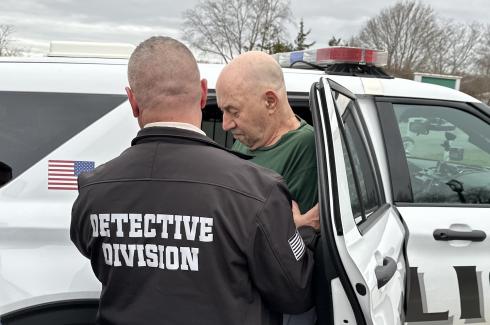Around 11 p.m. on a frosty Sunday night, Simon Clarke, a volunteer with the East Hampton Fire Department, had just turned off the light and gotten into bed when his department-issued pager went off. “No one wants to get out of bed, having just climbed in,” he said. “And it’s a really cold night, and it’s windy, and everything else — but you know that everyone else will be feeling the same, and so you go anyway. Everyone jumps in their cars and drives there, and then you deal with whatever is going on.”
The call was for a carbon monoxide alarm that had been triggered by a malfunctioning boiler, but the department relies on volunteers responding without hesitation to calls at any time of day or night, regardless of circumstances. “You just don’t know what you’re going to get. Every building’s different, every fire’s different. My wife always says, ‘What happens if no one goes?’ Well, the house will burn,” he said. “I’ve never been to a fire where there aren’t enough people, but it just depends on who’s around.”

A former member of the British Army, Mr. Clarke moved from London to East Hampton with his wife about four years ago; he planned to volunteer with the department before leaving the U.K., both to meet people and as a way to serve his new community. “It’s great to be part of a team, to have a common purpose,” he said. “There are guys who work in landscaping, contractors, attorneys, plumbers, finance people — people that work for the town and the village — it’s a great mixing pot. People have different opinions on how to do things, or politics, but all of that kind of melts away when you’re training, or go to a fire.”
“When people first sign up to join they have different motivations, but the end goal is always to protect the community to the best of your ability,” said Kate Kastrati, who works as the department secretary for both fire and emergency services. She grew up in East Hampton, seeing members of the department in village parades and on annual field trips to the firehouse. She became an E.M.S. volunteer in May of last year, and in February joined the Fire Department, too, after getting to know members while responding to shared calls.
“Even though I had that initial motivation to join, I was consistently inspired by the department. I’m not sure if you’re aware of the statistic, but female firefighters make up, I think, about 10 percent of the firefighter force in the United States. That number was a little unnerving before joining, but when I joined I was met with respect,” she said. “The kind of relationships that you build with people in this kind of a field is something that you can’t mimic anywhere else. These are people that you go through some really challenging calls with, and that dynamic really builds a strong bond.”
“Your first year in is your hardest,” said Chief Duane Forrester, who joined the department in 1994 and took the helm in 2022. He, like everyone else, balances his duties with a full-time job — in his case for the town’s Highway Department. “Not only are you having to learn everything, but there’s a quota of the meetings you have to meet, the calls you have to meet, and you have a certain amount of time to complete fire school — and fire school is like an actual college course now, and if you fall behind you need to start over with a different class. Luckily we haven’t had that yet, but it’s a lot of work.”
As chief, he is responsible for organizing emergency responses in real time, with whatever volunteers are able to make it to the scene, and they are constantly looking for new recruits to make sure that responses continue to be as quick as possible. Over the last few years they have added QR codes to department vehicles, which link to a form with more information about volunteering, and they plan to host an informational open house at their headquarters on North Main Street in January.

“Not everyone has to be inside the fire. There are plenty of jobs that need to be done, so you don’t necessarily have to fit into a certain category, or be the guy that’s always rushing through the door,” the chief said. People can also support the department through monetary donations, and even by checking that their smoke and carbon monoxide alarms are working, chimneys and furnaces are cleaned, and by moving out of the way for courtesy lights on volunteer vehicles in traffic — blue are for the fire department, and green for E.M.S.
“One of our biggest hurdles is actually getting guys either to the scene or to the firehouse to get equipment, so if people don’t extend that courtesy, a two-minute ride from Cooper Lane turns into 15 minutes, and then that’s a 15-minute delay on getting an engine or ladder or ambulance. If someone’s having a heart attack, there’s only so much time you have,” he said. “But even something small, like in the winter if you go out and shovel, like, a three-foot radius around a fire hydrant, that would help us out,” the chief said. “Because if someone’s house is on fire, we get there and we have to start shoveling.”
“It’s about being prepared for the thing you can’t prepare for,” Mr. Clarke said. “It’s really difficult to describe, but if there’s a proper fire, you can get, like, acrid, thick black smoke, and you literally can’t see your hand in front of your face, and so just imagine doing something in a complete blindfold, with really big, thick gloves on, and then heavy gear. You get used to it, and you train for it, but it’s very unusual.” Still, he said, responding to those calls, and being able to help, “is always a real highlight of the day.”




